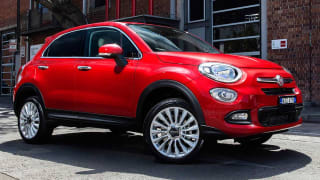
Fiat 500X 2015 review
Paul Gover road tests and reviews the Fiat 500X with specs, fuel consumption and verdict at its Australian launch.
Browse over 9,000 car reviews
In a world crammed with SUV blandness, the Citroen Cactus is like a cool change on a sweltering summer day.
Nothing else on the road today looks like the Cactus and only the Renault Captur mines the same vein of funkiness.
The company that put the quirk into quirky has more than just a boxy body — with those shopping trolley-proof mattresses on the doors — to announce its late arrival into the booming baby SUV class.
It also has an airbag that explodes out of the roof instead of the dash, windows in the rear doors that pop out instead of winding down, a low-level dashboard with two digital display pods and much more.
Predictably, the engine action starts with a three-cylinder turbo and there is also a 1.6-litre four-cylinder diesel. Citroen Australia predicts the diesel will garner about 85 per cent of Cactus sales because it’s the only engine matched to an automatic, in this case a self-shifting robotised manual.
The level of standard equipment is good but the starting price of $26,990 is not as sharp as many rivals, inviting comparison more with the Fiat 500X than a Mazda CX-3. The diesel auto is $29,990.
The big difference in the Cactus — and what’s created a Citroen waiting list for the first time in living memory — is the potential to personalise the car.
On the diesel front, the engine might be good but the robotised manual shift is ancient and awkward.
The maker reckons there are more than 21,000 combinations of body and Airbump cladding colours, roof choices and interior trim.
Citroen expects the Cactus to become its top seller in Australia but that’s not saying much when the current champion is its Berlingo van and baby SUVs sell so well.
Australia had to wait for the Cactus because it was not originally intended for right-hand drive.
There is no change from the global name, despite the unfortunate connotations (in this market at least).
The company has other challenges. There’s the lack of a proper auto, Citroen’s status as a challenger brand, a single cupholder that’s basically useless, the too-high load-over height into the boot and pop-out back windows. But Citroen is serious and the Cactus makes an instant impact on any road.
The Cactus is extremely comfortable, with seats that cuddle you instead of expecting you to sit on top, outward vision is great and it has a rear-view camera and parking radar.
The seven-inch infotainment screen is handy, I like the smaller rectangular speed readout and the glovebox is giant and useful.
The petrol engine is perky and the five-speed manual shifts well — but do young families really want a manual transmission?
On the diesel front, the engine might be good but the robotised manual shift is ancient and awkward. It is slow to change, never really works with the driver in traffic, and means the car is often struggling to keep up with traffic.
But I really like the plush ride and powerful brakes and the light and easy steering. The Cactus is handy for parking.
Rear seat space is not brilliant but definitely better than in a CX-3. And it’s unusual to find a full-sized spare in a car in this class.
The manual-petrol combination works well in the ’burbs and beyond. It has reasonable overtaking pace and is easy on the fuel.
Even the diesel is better once it’s away from regular slowcoach changes in stop-start traffic, running solidly in the upper gears. There are also paddles that make downshifts and overtaking easier but I’m never totally happy with the gearbox.
The aircon is excellent on a hot day, the ride is fluid and relaxing at highway speeds — and did I mention the seats?
It’s also fun to look around for Citroen quirks, such as the contrast between a regular handbrake lever in the manual and a giant item that looks more like Thor’s hammer in the auto version.
I would never option the glass sunroof, despite Citroen’s claims of UV protection.
The value is not great but I can see people turning to the Cactus because they want something practical and different. Now, if only the Citroen people in Paris would accept the need for a proper automatic in Australia.
Price
A starting sticker of $26,990 is high for the class, and the diesel is even higher from $29,990, but ample standard equipment includes a reversing camera.
Technology
There’s nothing special in the Cactus. Robotised manual gearbox, which Citroen calls an auto, is old and clunky.
Performance
The Cactus is no fireball but the base engine is perkier than in the Renault Captur. Good fuel economy compensates.
Driving
A potential class leader with cushy ride, good grip in corners and excellent vision. Would be relaxing on the longest runs.
Design
A striking newcomer that’s all about customisation, from Airbump panels to body and roof colours, plus user-friendly cabin. Quirky still but in a good way.
| Vehicle | Specs | Price* | |
|---|---|---|---|
| Exclusive 1.6 E-HDi | 1.6L, Diesel, 6 SP | $16,170 – 20,790 | 2016 Citroen C4 Cactus 2016 Exclusive 1.6 E-HDi Pricing and Specs |
| Exclusive 1.2i Puretech | 1.2L, ULP, 5 SP MAN | $11,110 – 15,180 | 2016 Citroen C4 Cactus 2016 Exclusive 1.2i Puretech Pricing and Specs |
$11,110
Lowest price, based on third party pricing data